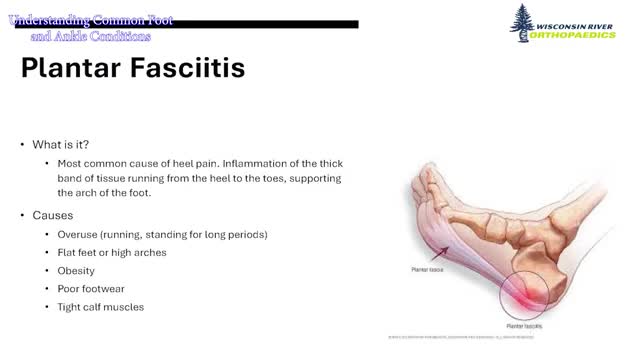Orthopedic surgeon outlines common foot and ankle problems, conservative treatments in Wisconsin Rapids talk
October 22, 2025 | Wisconsin Rapids, Wood County, Wisconsin
This article was created by AI summarizing key points discussed. AI makes mistakes, so for full details and context, please refer to the video of the full meeting. Please report any errors so we can fix them. Report an error »

Dr. Tyler Sorensen, a fellowship-trained foot and ankle surgeon with Wisconsin River Orthopedics, described common foot and ankle conditions and treatment options during a community health talk in Wisconsin Rapids. He emphasized early evaluation, conservative treatments and the link between foot problems and overall mobility.
"Mobility is freedom," Sorensen told the audience. He said many foot and ankle conditions are progressive and easier to treat when addressed early, and that foot problems can sometimes signal broader health issues such as vascular or rheumatologic disease.
Sorensen reviewed several frequently seen problems. For plantar fasciitis, he said patients typically report sharp heel pain on the first steps after resting, and that 85 percent of people improve with conservative care including calf stretching, supportive shoes or inserts, anti-inflammatory medication, ice, physical therapy, night splints and, sometimes, injections. He warned that chronic, untreated cases may eventually require surgery.
On bunions, Sorensen said the underlying issue is a bony malalignment of the first metatarsal and that genetics are the primary cause. He recommended wider shoes, padding, taping or orthotics for symptom relief, and said modern corrective procedures focus on realignment rather than simply shaving the bump.
For ankle sprains, Sorensen encouraged early movement and rehabilitation: rest, ice, compression and elevation initially, followed by bracing and early physical therapy to restore proprioception and prevent chronic instability. He noted that complications from repeated sprains can include cartilage defects that may lead to arthritis.
He described Achilles tendinitis as an overuse injury driven by sudden activity increases, obesity or tight calf muscles, with treatment priorities of rest, activity modification, stretching, heel lifts or orthotics and physical therapy. For flat feet, Sorensen recommended supportive footwear, calf strengthening, bracing when indicated and weight management; he said surgical reconstruction can be an option if conservative care fails.
Sorensen also covered hammertoes, ingrown toenails, and arthritis of the foot and ankle. He noted that ankle replacement is an available option for end-stage ankle arthritis and that preserving joint motion can relieve pain and reduce stress on adjacent joints.
During a question-and-answer period, audience members asked about injections, nerve symptoms and peripheral neuropathy, shoe choice, insurance acceptance and when to seek evaluation. Sorensen said injections can provide temporary relief but may be less effective if repeated; that nerve issues require individual assessment and sometimes vitamin supplementation; and that his clinic accepts multiple insurance plans and offers walk-in evaluation without referrals.
Sorensen closed by encouraging residents to seek care while symptoms are active so providers can better localize the problem and recommend appropriate treatment options.
"Mobility is freedom," Sorensen told the audience. He said many foot and ankle conditions are progressive and easier to treat when addressed early, and that foot problems can sometimes signal broader health issues such as vascular or rheumatologic disease.
Sorensen reviewed several frequently seen problems. For plantar fasciitis, he said patients typically report sharp heel pain on the first steps after resting, and that 85 percent of people improve with conservative care including calf stretching, supportive shoes or inserts, anti-inflammatory medication, ice, physical therapy, night splints and, sometimes, injections. He warned that chronic, untreated cases may eventually require surgery.
On bunions, Sorensen said the underlying issue is a bony malalignment of the first metatarsal and that genetics are the primary cause. He recommended wider shoes, padding, taping or orthotics for symptom relief, and said modern corrective procedures focus on realignment rather than simply shaving the bump.
For ankle sprains, Sorensen encouraged early movement and rehabilitation: rest, ice, compression and elevation initially, followed by bracing and early physical therapy to restore proprioception and prevent chronic instability. He noted that complications from repeated sprains can include cartilage defects that may lead to arthritis.
He described Achilles tendinitis as an overuse injury driven by sudden activity increases, obesity or tight calf muscles, with treatment priorities of rest, activity modification, stretching, heel lifts or orthotics and physical therapy. For flat feet, Sorensen recommended supportive footwear, calf strengthening, bracing when indicated and weight management; he said surgical reconstruction can be an option if conservative care fails.
Sorensen also covered hammertoes, ingrown toenails, and arthritis of the foot and ankle. He noted that ankle replacement is an available option for end-stage ankle arthritis and that preserving joint motion can relieve pain and reduce stress on adjacent joints.
During a question-and-answer period, audience members asked about injections, nerve symptoms and peripheral neuropathy, shoe choice, insurance acceptance and when to seek evaluation. Sorensen said injections can provide temporary relief but may be less effective if repeated; that nerve issues require individual assessment and sometimes vitamin supplementation; and that his clinic accepts multiple insurance plans and offers walk-in evaluation without referrals.
Sorensen closed by encouraging residents to seek care while symptoms are active so providers can better localize the problem and recommend appropriate treatment options.
View full meeting
This article is based on a recent meeting—watch the full video and explore the complete transcript for deeper insights into the discussion.
View full meeting
